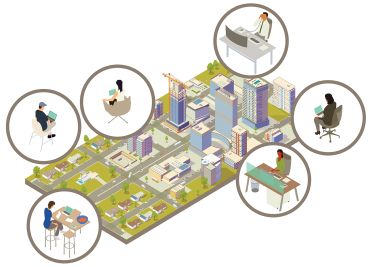This Is Only the Beginning for SPACs in Real Estate
Will the SPAC boom spur innovation in proptech, or distort valuations? Or both?
By Chava Gourarie March 2, 2021 12:00 pm
reprints
Get used to SPACs in commercial real estate, at least for a while.
One of the definitive business trends of 2020, that has only solidified in 2021, is the newfound popularity of an existing on-ramp to the public market: the special purposes acquisition company, or SPAC.
These blank-check companies raise capital in an initial public offering, which sits in a trust, while the sponsor goes out in search of a target company — usually a high-growth startup — to merge with. Once the merger is complete, the ticker is changed to that of the target company, and voila: It is now a publicly traded company.
Historically, SPACs have been slightly tainted, viewed as an alternative for companies who couldn’t pull off a traditional IPO. As the vehicle becomes more popular, however, its credibility is improving because the types of sponsors, investors and target companies using the vehicle are more sophisticate and better capitalized.
“[SPACs] are now being viewed by entrepreneurs as a legitimate way to exit your business,” said Zach Aarons, co-founder and general partner at VC firm MetaProp.
The SPAC boom is now exploding in earnest in real estate, where three threads are converging: More generalist companies are launching SPACs with a focus on proptech; more institutional real estate firms are launching their own SPACs; and, as a result, more proptech companies are completing mergers and coming to market, providing performance, valuation and pricing data for other companies to follow.
Just as in the rest of the SPAC space, the appetite for deals from sponsors and investors is voracious.
Since August, 24 real estate-focused SPACs have raised $7.4 billion in initial capital in search of a target, with $3.9 billion of that raised just in 2021, according to an analysis by Commercial Observer based on Spactrack data. Since the start of the year, real estate heavyweights Silverstein Properties, RXR Realty, and Crown Acquisitions launched their own SPACs, as did proptech-focused VC firm Fifth Wall, while Tishman Speyer launched a second SPAC, after announcing a merger with smart home platform Latch in December for its first one.
(To clarify some terms: A sponsor first announces a SPAC; then, several weeks later, launches the IPO once federal regulators approve it. Once the sponsor chooses a target company, the merger is announced, and is usually completed several months later, in what is sometimes referred to as the de-SPAC. In many cases, the sponsor will raise a private round of investment in order to close the deal with the target company, prior to the merger announcement, called a PIPE for Private Investment in Public Equity.)
It’s still very early days, so there are only a handful of pending or closed proptech mergers on the market, including the aforementioned Latch and 3D-imaging platform Matterport (announced last month) as well as Opendoor and Porch.com, both of which completed their mergers in December.
There are divergent opinions on whether the SPAC mania is, in fact, a mania that will flood the market and distort valuations, or a healthy financial evolution in response to a broken IPO system. “There will be bad companies that get funded, and there will be winners,” said Ben Friedman, CFO of BOA Acquisition Corp., a $200 million SPAC launched this month. “This is just the evolution of the capital market, and it’s an incredibly exciting time as a result.”
It’s certainly a time of disruption. With so much capital sloshing around in the market, at such an uncertain time for real estate, capital will certainly get redirected to companies and ideas it might not have otherwise —for better or for worse. At the same time, the SPAC structure means more investors — both institutional and retail — will have access to growth companies earlier in their trajectory.
The arrival of the SPAC didn’t come from nowhere. The vehicle has been around for decades as one option on the menu for companies looking to go public, but tends to fall out of favor during financial downturns, including after the dot-com boom and the Great Recession. Just one blank-check company IPOd in 2009, for instance. The next year, it was seven. After that, the numbers grew pretty steadily, until, by 2019, there were 59.
In 2020, that quadrupled to 237, comprising about 50 percent of the total IPO market, more than ever before.
In 2021, the number of SPACs appears to have infinitized. We’re at 128 and we haven’t even made it through the first quarter.
One factor contributing to the explosion is liquidity in the market. With the massive federal intervention to prop up markets during the COVID-19 pandemic, and extraordinarily low interest rates, the cost of capital is low and investors are looking for returns, said Patrick McGrath, chief information officer and head of client technologies at brokerage Savills.
“Over 2020, you’ve seen an expansion of monetary supply,” McGrath said. “That’s part of the broader environment that’s influencing demand, in general, for investments and, specifically, equity investments.”
There’s also been a tremendous increase in retail investment throughout 2020, and that’s added to demand from a new set of investors who only have access through the public markets. The retail investment boom doesn’t only expand the pool of investors, it also offers a different investor profile than institutional investment. “There are a lot of names in proptech that may not have the institutional demand, but they have the demand from retail investors,” Aarons said.
Last month, Matterport became the latest proptech startup to announce it would go public via a SPAC from repeat sponsor Gores Group, called Gores Holding VI (GHVI). The deal valued the 3D-imaging company at $2.9 billion, on revenue of $85.9 million in 2020.
“How would that investor have ever invested in a company like Matterport?” McGrath said. “Through the GHVI entity, they can buy shares. They wouldn’t have had access through VCs to the same pool of investments.”
And the market really wanted Matterport. After the deal was announced, shares in the blank-check company popped from the standard starting point of $10 per share, to a peak of $24, then retreated somewhat. It was trading near the $16 mark at the end of February. “If GHVI was saying we’ll invest at $10, the market has shown they’re willing to accept a much higher valuation,” McGrath said.
Shares of TS Innovation Acquisition Corp. (TSIA), the Tishman-sponsored SPAC that is merging with Latch, had a similar trajectory. After the merger was announced, shares in the shell company bounced up to $22, and also settled closer to $15.
But this, truly, is only the beginning, since the majority of the proptech-focused SPACs have only just launched and are currently searching for a company to merge with. Also, there’s no reason to believe there won’t be more SPACs launching soon.
There are some concerns that the SPAC model, especially in such a competitive environment, could lead to bad deals and distort ed valuations. The SPAC process has fewer checks than a traditional IPO, relying on just the sponsor to evaluate and price the company. And with so many sponsors in the market out looking for a meal, startups can demand higher revenue multiples, and, since SPAC targets are generally growth companies whose upside is in their promise, they can be difficult to value.
“If you don’t have a broad set of opportunities to invest, but there’s so much demand to make the investments, you’re going to start to see some not-so-great investments get made, that’s just the inevitable [outcome],” McGrath said.
Still, the SPAC boom might be self-correcting, as more credible sponsors and startups participate. Jordan Vogel, co-founder of Benchmark Real Estate Group, which has sponsored two SPACs, said he doesn’t think the space is too crowded. “There’s a few hundred more SPACs than I would prefer, but there’s thousands of companies that now see SPACs as a credible way to come to market,” Vogel said, giving sponsors a large variety to choose from.
Vogel was one of the first in the real estate industry to ride the new SPAC wave, launching Property Solutions Acquisition Corp. in July. Initially, Vogel was searching for real estate tech companies, but chose to merge with luxury electric car maker (a.k.a. Tesla rival) Faraday Future instead, after surveying the market. “I’m opportunistic,” Vogel said. “If we find a super-exciting deal in a different industry, we’d pursue that.”
Now, Vogel has launched a second proptech-focused SPAC and the landscape is very different, he said. Back in July, when he would meet potential target companies, they would hardly have time for the financial presentations. “We would spend 45 of the first 60 minutes explaining technically how a SPAC works, and the pros and cons of a SPAC structure versus an IPO structure,” Vogel said. “That doesn’t happen anymore.”
Even if more credible sponsors are piling into the SPAC space, the inherent structure of the model, which bypasses the lengthy IPO process, is what made people skeptical to begin with.
“The long, drawn-out IPO gives people a chance to hone in on what people are willing to pay,” said Alexander Snyder, a portfolio manager at CenterSquare Investment Management. “SPACs can go both ways, they can shoot up or crash.”
With SPACs, investors are relying on the evaluation of the sponsors only, and that evaluation is based on different information than in IPOs, which have much more rigorous reporting requirements. SPAC hopefuls can share projections of future revenue and profit, while companies en route to an IPO can only report on past performance. “In a lot of cases, [the target companies] aren’t making money,” Snyder said. “They’re basically concepts.”
In fact, a significant chunk of SPAC mergers over the last several months have gone to electric vehicle companies, including, most recently, flying taxi startup Joby Aviation, which announced a merger with a SPAC at a $6.6 billion valuation. Joby had no revenue in 2020, and expects to generate revenue for the first time in 2024, then make $2 billion in revenue by 2026. That’s because they expect to be the first-to-market with an airworthy taxi.
“A lot of electric vehicle companies have no revenue, they have the technology and promise,” Aarons said, but it’s different for real estate companies. “I think the bulk of proptech companies, they either have significant revenue traction or significant tech traction that has been demonstrated.”
There’s still one more concern about SPACs, though: There is a hefty upside for the sponsor, making it pretty lucrative for companies to do a SPAC, get their fees, and head out the door. “Within the SPAC vehicle, you’ve got some incredible incentives for sponsors that make it, potentially, a very profitable allocation of their time,” McGrath said.
Sponsors get both fees and a significant slice (usually 20 percent) of the equity, and they can then walk away after six months, which could incentivize them to consider deals without regard for long-term outcomes, or to close deals at higher valuations than the market will support.
In an ideal scenario, the sponsor is a benefit of the SPAC model over the IPO model, providing the target company expertise and industry connections, and that’s a case that institutional real estate companies have made. “We’re very differently situated than most SPAC sponsors,” CBRE president and CEO Bob Sulentic said during the company’s fourth-quarter earnings call. “We’re not really thought of as a financial sponsor. We’re thought of as a strategic sponsor.”
That being said, if shepherding target companies through the early stages of going public is not part of a company’s core business, there isn’t a lot of downside to stepping out once the deal is done. Though, the competitive market might correct itself here, as well, as target companies will have a variety of sponsors to choose from. “It’s a pretty significant decision for them. It’s a marriage in a sense,” Aaron said.
“Sponsorship matters more and more; you want a sponsor who cares how it performs afterwards, because they care about their reputation,” Snyder said.
There are ways to adjust the SPAC models, so that the outcome for the sponsor is more closely aligned with the target company, and the markets could see some evolution if the SPAC wave, indeed, persists and the vulnerabilities are further exposed.
In the meantime, there is a definite positive to so much capital directed to innovation and technology. Real estate started to see more VC and institutional capital flow toward technology beginning in roughly 2014, and this is adding another layer to it.
“This is definitely driving additional investment into new ways of working across the world’s largest asset class, across new ways of building, new ways of managing and capturing information,” Savills’ McGrath said.
“Even semi-unproven business models are now going to be fairly well capitalized, to recruit interesting minds to think through some of the traditional challenges in our markets and how that can be revolutionized. The tailwind for innovation is pretty strong.”


